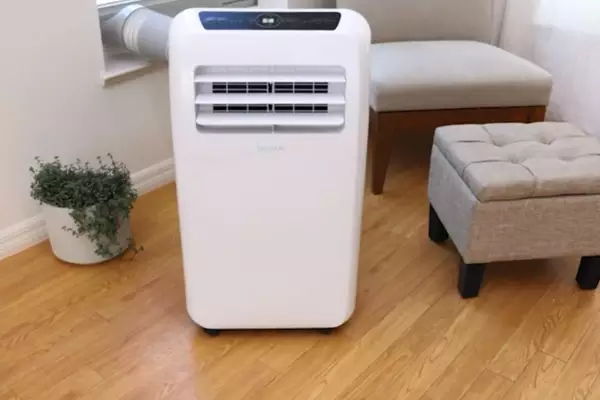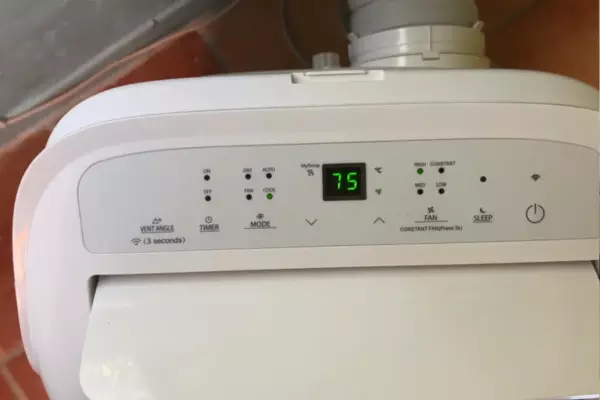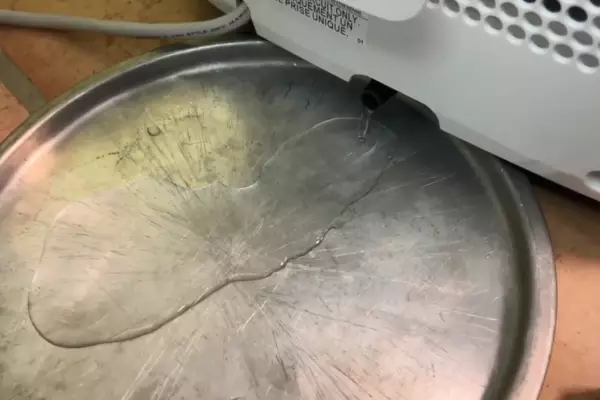Air conditioning has revolutionized indoor living, providing comfort regardless of outdoor temperatures. At the core of its operation lies a simple yet elegant process, where air is cooled, and in doing so, produces water. Portable air conditioners, convenient for their mobility, also follow this process.
The creation of water in air conditioning is not an anomaly but a result of its core function: removing heat. This condensation process results in water that needs to be managed efficiently. Without effective water drainage, an air conditioner’s operation may be hindered, and in some cases, it can even pose a risk to the device itself.
Dealing with this water drainage is a key aspect of maintaining a portable air conditioner. Neglecting this task could lead to a decrease in the device’s efficiency or even result in damage. Understanding how to manage water drainage can help extend the life of your portable AC unit and ensure it runs smoothly.
Contents
How Portable Air Conditioners Function
Cooling Mechanism Basics
A portable air conditioner works by drawing in warm air from the room, cooling it via a process called phase conversion. This is when a refrigerant absorbs the heat and turns from a low-pressure gas into a high-pressure liquid. This process causes the refrigerant to become cold, and the air conditioner’s fan blows air over the cold refrigerant to cool the room.
Water: Byproduct of Cooling
When the warm room air is cooled, the moisture in the air condenses on the cold evaporator coils, forming droplets of water. This water is the byproduct of the cooling process.

Water Draining: An Essential Aspect
Reasons for Water Drainage
The condensed water must be drained out of the air conditioner to prevent damage to the unit and keep it working efficiently. If the water isn’t drained, it could cause the unit to overflow, leading to potential water damage in your home.
Methods of Water Drainage
Most portable air conditioners use one of three methods to manage this water:
- Self-evaporation: Many modern portable air conditioners are equipped with a self-evaporative system. This means that the water produced by the cooling process is recycled and used to cool the cooling coils, thereby increasing efficiency.
- Gravity drainage: For units without a self-evaporative system, water is usually drained through a hose that is run to a drain or outside. The water drains by gravity, so the hose must be run downward.
- Bucket drainage: If neither of the above methods is feasible, a bucket or pan is placed inside the unit to collect the water. The bucket must be manually emptied periodically to prevent overflow.
Two Drains in Portable ACs: Facts and Functions
Portable air conditioning units are designed to be user-friendly and practical. Their designs often include features that enhance their usability and maintenance ease, such as having two drains.
Rationale Behind Two Drains
The concept of two drains may seem complex but it’s rooted in practicality. A typical portable AC will have a primary and a secondary drain. The primary drain takes on the brunt of the work, processing most of the condensation that is produced by the unit. The secondary drain, on the other hand, acts as a backup system, kicking in when the primary drain is overwhelmed or blocked.
Primary and Secondary Drains Explained
In essence, the primary drain is the unit’s main workhorse. It is typically located at the bottom of the device, allowing for optimal gravitational flow of the water. Most of the time, it can handle the amount of water the air conditioner produces. However, in conditions of high humidity where more condensation is produced, the primary drain might need assistance.
That’s when the secondary drain comes into play. Positioned higher on the unit, the secondary drain is designed to handle overflow scenarios. When water in the unit reaches the level of the secondary drain, it starts to work, draining off the excess water that the primary drain can’t handle.
This two-drain system is not only functional but it also serves as a handy diagnostic tool. If you notice water exiting from the secondary drain, it’s a clear sign that the primary drain isn’t working as it should and needs attention.

Leaving the Drain Plug Off: Pros and Cons
Deciding whether to leave the drain plug off on a portable air conditioner can be confusing. This section will guide you through the pros and cons of this practice.
Impact on Air Conditioner Performance
Leaving the drain plug off essentially allows the water to drain continuously from your unit. This can be particularly beneficial if you live in a humid environment where your air conditioner generates a large amount of condensation. With the drain plug off, the unit can operate for longer periods without the need for manual intervention to drain the water.
Potential Risks Involved
However, leaving the drain plug off is not without its risks. Firstly, continuous drainage could potentially cause water damage if your unit is positioned on a non-water-resistant surface or in an area of your home where water could cause issues.
Secondly, by constantly draining away the water, especially in dry environments, you could exacerbate the dryness in the air. Air conditioners, by their nature, dry out the air. If you remove the ability for some of that moisture to be returned to the room, you could make the environment uncomfortably dry.
Draining a Cool Living Portable Air Conditioner
Like other brands, Cool Living Portable Air Conditioners also require regular water draining for optimal performance. This process is quite straightforward and can be done in a few steps.
Identifying the Drain Plug
The first step in draining your Cool Living Portable Air Conditioner is to locate the drain plug. It’s usually situated at the back or bottom of the unit. Check your user manual for precise location.
Steps for Safe and Efficient Drainage
- Firstly, turn off and unplug your air conditioner to avoid any electrical hazards.
- Move the air conditioner to a location where water can be safely drained. This could be a drain, sink, or outside.
- Remove the drain plug and let the water flow out. If your unit has been running for a long period, there could be quite a bit of water, so be prepared.
- Once the water has completely drained, don’t forget to replace the plug securely before moving the air conditioner back to its original location.
Adding Water to a Portable Air Conditioner
Some portable air conditioners come with the unique feature of adding water to the unit to boost cooling efficiency. Here’s how and why you would do it.
Purpose of Adding Water
In these models, water is used to enhance the cooling capacity of the unit. The added water helps to cool down the refrigerant, which can result in improved cooling performance. This feature can be especially helpful in hot and dry environments where additional cooling is needed.
Steps to Safely Add Water
- Locate the water inlet on your air conditioner. This is usually marked and should be mentioned in your user manual.
- Using a clean, dry funnel, slowly pour water into the inlet. Do not exceed the maximum level indicated on the unit.
- Once done, make sure to securely replace the cap on the inlet to prevent any water leakage.

Maintenance Tips for Portable ACs
A well-maintained portable air conditioner can serve you efficiently for many years. Here are some maintenance tips, with a special focus on water handling.
Regular Draining: A Necessity
Depending on the humidity level in your area, you may need to drain the unit as frequently as once every eight hours of use. Regular draining is essential for the efficient functioning of your portable air conditioner.
Best Practices for Water Handling
To manage water in your portable air conditioner effectively, keep the following tips in mind:
- Regularly check the water level if your air conditioner uses a bucket to collect water. Do not let the bucket overflow.
- If your unit uses gravity to drain water, ensure the drain hose is not bent, kinked, or blocked in any way.
- For units with a self-evaporation system, it’s important to ensure the system is functioning correctly. Regularly check your unit for any signs of malfunction.
FAQs on Portable AC Water Management
Why is my portable air conditioner not draining water?
If your portable air conditioner is not draining water, the drain might be clogged. Unplug the unit, locate the drain, and check for any blockages. Clear any blockages and replace the drain plug securely.
Is it normal for a portable air conditioner to produce a lot of water?
Yes, it is normal for a portable air conditioner to produce water. The amount of water produced can depend on the humidity level in the room. Higher humidity levels can result in more water production.
Can I use a portable air conditioner without draining the water?
If your portable air conditioner has a self-evaporative system, you may not need to manually drain the water. However, for other models, regular water drainage is essential to prevent damage to the unit and ensure efficient operation.
Conclusion
The operation of portable air conditioners involves more than just providing cool air. Water management forms a crucial part of its functioning. How a unit drains water can impact its efficiency, and knowing how to properly manage this aspect can help you get the most out of your device.
In the world of portable air conditioners, understanding water drainage isn’t just about maintenance. It’s also about ensuring optimal performance and longevity of the device. From the significance of dual drains to knowing when to leave the drain plug off, each aspect plays a role in achieving a well-functioning unit.
Ultimately, being aware of these aspects can help you make informed decisions about your portable air conditioner. With proper knowledge and care, you can ensure your device performs at its peak, providing you with cool and comfortable air no matter the weather outside.

